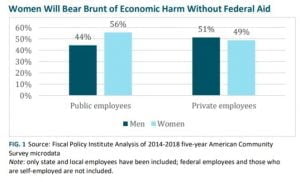New York’s public sector workforce is comprised of many of our state’s essential workers: nurses, teachers, firefighters, personal care aides, childcare workers, and more. In total, 24 major occupational groups – defined as having 10,000 or more workers – are part of the sector.
A recent economic news release from BLS indicates that over 100,000 public sector workers in New York were laid off from their jobs between February and May of 2020 due to the Coronavirus pandemic and declining state revenues.
Characteristics of New York’s Public Sector Workforce
• Nearly 1.3 million workers comprise New York State’s public sector workforce. 
• Women represent a larger share of the public sector workforce at 56 percent. By comparison, the private sector workforce is comprised of 49 percent women.
• Black workers also make a larger share of the public sector workforce than the private sector workforce: 18 percent versus 13 percent.
• The largest share of workers in the public sector – 27 percent – is concentrated in the 45-54 age group, and a third of the workers hold advanced degrees. For the private sector, the largest share of workers – 25 percent – is found in the 25-34 age group, with 30 percent of all workers possessing a high school diploma or less.
New York State’s workers have already been economically harmed by the pandemic. While the private sector lost millions of workers in the first weeks of the pandemic due to the state’s shutdown order, many public sector workers continued working because they were either deemed essential or because they were able to safely work from home. However, New York State has projected over $13 billion in revenue losses as a result of the pandemic, with cuts planned for state operations, aid to localities, and school districts. Congress must act swiftly to provide federal aid to state and local governments to protect workers, families, public health, and the economy.
Major Occupations That Comprise the Public Sector Workforce
| Accountants And Auditors | Administrative Support Workers | Postsecondary Teachers |
| Bus Drivers, School | Janitors And Building Cleaners | Registered Nurses |
| Bus Drivers, Transit And Intercity | Lawyers, Judges, and Magistrates | Secondary School Teachers |
| Childcare Workers | Nursing Assistants | Secretaries And Administrative Assistants |
| Correctional Officers | Office Clerks, General | Security Guards |
| Education & Childcare Administrators | Other Managers | Social Workers |
| Elementary & Middle School Teachers | Personal Care Aides | Special Education Teachers |
| Firefighters | Police Officers | Teaching Assistants |
FIG. 2 Source: Fiscal Policy Institute Analysis of 2014-2018 five-year American Community Survey microdata
Download the Factsheet pdf.
